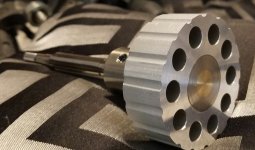C
cloudrepair
Guest
just to be clear..alex shoots well. and builds great rifles.
I believe you
And I believe if you dial in both ends of the barrel
and prebore then ream without a pilot trying to influence the reamer to follow the bore instead of the dialed in points
you intend it to follow and end up at. You will get the results you want with only a pusher that will allow this.
I think I will just adapt his idea to my existing titanium pusher holder that I know is true by taking my handles off and turn a full radius handle to press on
Out of alluminum.
And leave the ball out because I already have that built in
to my pusher.
That will true itself to the holder that already has a true perpendicular face to the reamer
Does that make sense
Last edited by a moderator:


